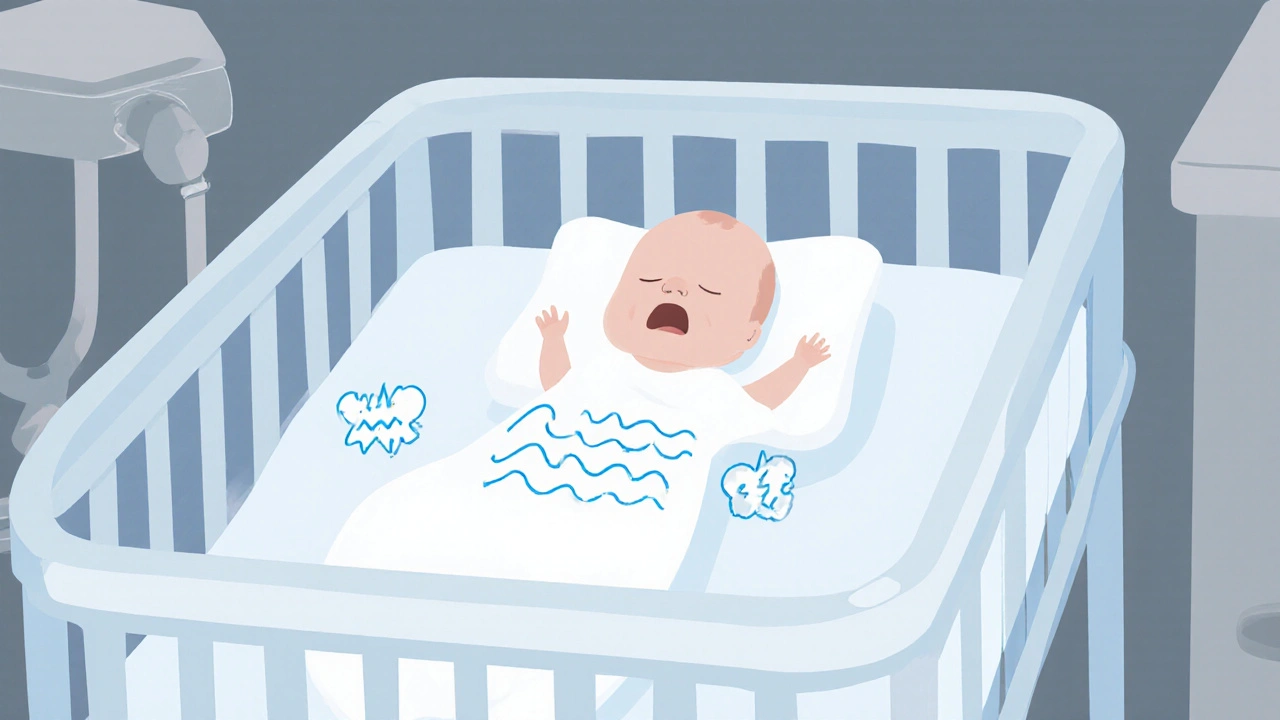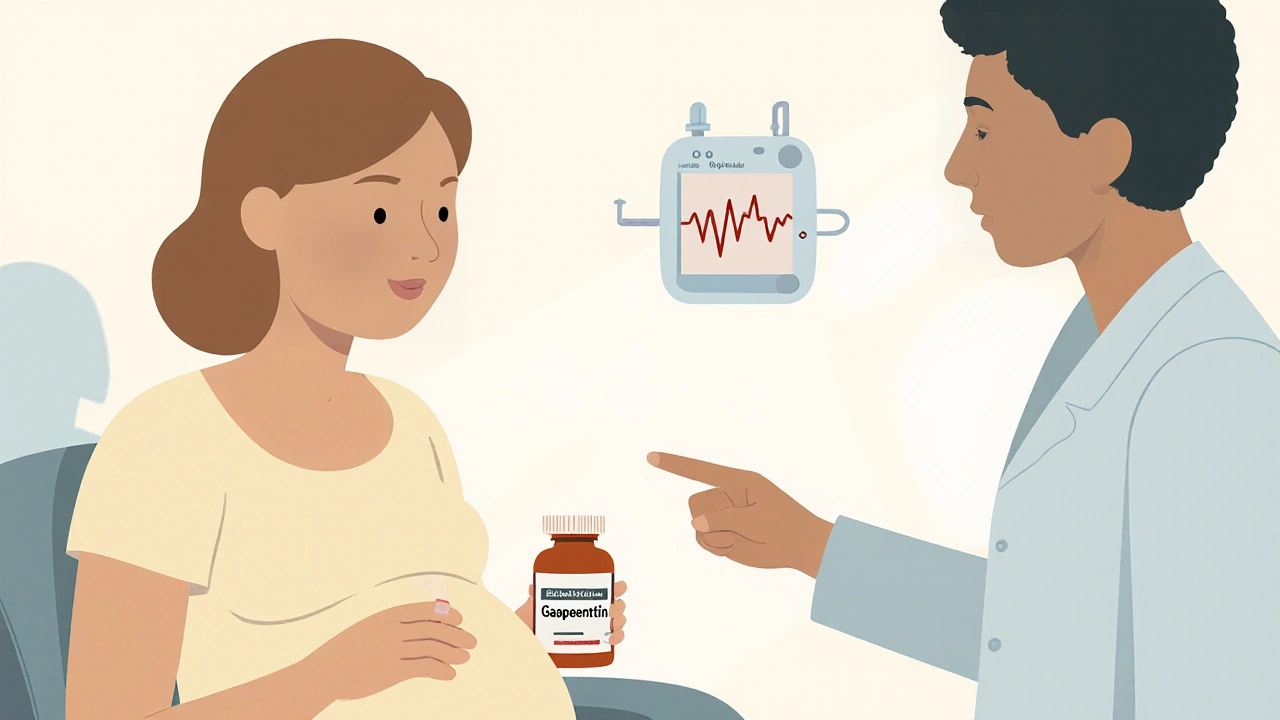When a woman is pregnant and struggling with chronic pain, anxiety, or seizures, the question isn’t just gabapentin pregnancy safety-it’s whether the relief she needs is worth the risk to her baby. Gabapentin and pregabalin, the two main gabapentinoids, are commonly prescribed for nerve pain, fibromyalgia, and even bipolar disorder. But as their use in pregnancy has surged-jumping nearly 20-fold in the U.S. between 2000 and 2014-so have concerns about what they might do to a developing fetus.
What Do We Know About Birth Defects?
The biggest fear for any pregnant person taking medication is major birth defects. The good news? Gabapentinoids don’t appear to cause the same level of risk as older drugs like valproic acid, which can lead to serious malformations in up to 11% of exposed pregnancies. Large studies, including a 2020 analysis of over 1.7 million pregnancies published in PLOS Medicine, found that gabapentin use during the first trimester was linked to only a tiny increase in overall major malformations-0.7% higher than baseline. That means if the general population risk is about 3%, the risk with gabapentin is roughly 3.7%. But here’s where it gets complicated. That same study found a clear signal for a specific type of heart defect: conotruncal defects. These are rare but serious abnormalities affecting the outflow tracts of the heart. The risk doubled-1.4 times higher-in women who took gabapentin consistently (two or more prescriptions) during pregnancy. The absolute risk? About 0.82% compared to 0.59% in unexposed pregnancies. That’s still low, but it’s enough to warrant attention. Pregabalin showed similar patterns in animal studies and is now flagged by the European Medicines Agency as having potential developmental toxicity.Neonatal Problems Are More Common Than Birth Defects
While major birth defects are rare, problems after birth are far more frequent. A 2018 study published in Neurology followed 209 pregnant women taking gabapentin. Of the babies exposed right up to delivery, nearly 38% ended up in the NICU. That’s more than 13 times higher than the 2.9% NICU admission rate in babies not exposed to the drug. These babies didn’t always have birth defects. Instead, they showed signs of neonatal adaptation syndrome-tremors, jitteriness, excessive crying, trouble feeding, and breathing irregularities. These symptoms usually show up within hours or days after birth and can last up to two weeks. They’re not life-threatening, but they’re stressful for families and require extra medical care. Why does this happen? Gabapentin crosses the placenta easily. It’s small, water-soluble, and reaches the baby’s bloodstream at levels similar to the mother’s. When the baby is born and no longer gets the drug through the placenta, their nervous system reacts. It’s like going cold turkey, but for a newborn. Unlike opioids, which cause severe withdrawal in over half of exposed infants, gabapentin’s withdrawal is milder-but still common enough that doctors now consider it a real clinical concern.Preterm Birth and Growth Issues Are Real Risks
The risks don’t stop at birth. Studies consistently show that women taking gabapentin during pregnancy are more likely to deliver early. The risk of preterm birth (before 37 weeks) is 34% higher. They’re also 22% more likely to have a baby who’s small for gestational age-meaning the baby didn’t grow as expected in the womb. These aren’t minor issues. Preterm babies face higher risks of breathing problems, infections, feeding difficulties, and long-term developmental delays. Small-for-gestational-age babies can have metabolic issues and struggle with weight gain after birth. Both outcomes are linked to maternal health conditions like chronic pain or anxiety-which are often the reasons gabapentin is prescribed in the first place. That makes it hard to separate the drug’s effects from the underlying illness. But even after adjusting for these factors, the association remains.
When Is It Still Worth Taking?
This isn’t a simple "don’t take it" story. For some women, gabapentin is the only thing that works. A 2023 survey of Canadian obstetricians found that 32% of doctors would still prescribe it during pregnancy-if the pain was severe and other options had failed. Think of someone with diabetic neuropathy so painful they can’t sleep or walk. Or a woman with treatment-resistant epilepsy where switching drugs could trigger seizures that harm both mother and baby. In these cases, the risk of not treating the condition may be greater than the risk of the drug. The American College of Obstetricians and Gynecologists (ACOG) says gabapentin should only be used when non-drug treatments (like physical therapy, acupuncture, or cognitive behavioral therapy) haven’t worked-and only if the condition is serious enough to justify the potential harm.What About Pregabalin vs. Gabapentin?
Pregabalin is stronger, faster-acting, and more potent than gabapentin. But it also appears to carry a higher risk profile. Animal studies show clearer signs of developmental harm at lower doses. The European Medicines Agency now recommends pregabalin be avoided in pregnancy unless there’s no alternative. In contrast, gabapentin has more human data, and while not risk-free, it’s the better-studied option. That’s why many clinicians now prefer gabapentin over pregabalin for pregnant patients-even though both are classified as FDA Pregnancy Category C (risk can’t be ruled out). If a woman is already on pregabalin and becomes pregnant, switching to gabapentin under medical supervision may be the safest move.
What Should You Do If You’re Pregnant or Planning to Be?
If you’re taking gabapentin or pregabalin and thinking about pregnancy-or you’re already pregnant-do not stop suddenly. Abruptly stopping can cause seizures, anxiety spikes, or severe withdrawal symptoms. Instead, talk to your doctor early. Ideally, have this conversation before conception. Ask:- Is this medication absolutely necessary?
- Have I tried non-drug treatments first?
- Can I lower my dose or switch to a safer alternative like lamotrigine or duloxetine?
- Should I get a detailed fetal echocardiogram if I continue taking it?
The Big Picture: A Changing Landscape
The FDA just announced in January 2024 that all gabapentinoid manufacturers must now track at least 5,000 pregnancy outcomes by 2027. That’s a big step. It means we’ll know more soon-not just about birth defects, but about long-term development. One ongoing NIH-funded study is tracking 1,200 children exposed to gabapentin in utero until age five, with early results expected in late 2025. Meanwhile, market trends are shifting. Pregabalin use in pregnancy is expected to drop by 25-35% by 2027 as doctors move toward safer alternatives or non-drug therapies. Gabapentin will likely remain in use, but more cautiously. The takeaway? Gabapentinoids aren’t a "safe" choice in pregnancy-but they’re not an automatic "no" either. They’re a tool with known risks, and like any tool, they need to be used wisely. For some, the benefits outweigh the risks. For others, there are better options. The key is not fear-but informed, individualized decision-making.Is gabapentin safe to take during pregnancy?
Gabapentin is not considered safe for routine use during pregnancy, but it may be used in specific cases where the benefits clearly outweigh the risks. Studies show a small increased risk of heart defects, preterm birth, low birth weight, and neonatal withdrawal symptoms. It should only be prescribed when non-drug treatments have failed and the condition is severe-like uncontrolled epilepsy or debilitating neuropathic pain.
Can gabapentin cause birth defects?
The overall risk of major birth defects is only slightly higher than normal-about 3.7% compared to 3% in the general population. But there’s a specific concern for conotruncal heart defects, which are rare but serious. The risk doubles with consistent use (two or more prescriptions), rising to about 0.82%. This is why fetal echocardiography is recommended if gabapentin is taken throughout pregnancy.
What are the signs of neonatal withdrawal from gabapentin?
Babies exposed to gabapentin near delivery may show signs of withdrawal within hours to days after birth. These include jitteriness, tremors, excessive crying, irritability, feeding difficulties, and breathing problems. About 38% of exposed newborns require NICU care, compared to just 3% of unexposed babies. Symptoms usually resolve within 1-2 weeks with supportive care.
Is pregabalin safer than gabapentin during pregnancy?
No. Pregabalin appears to carry a higher risk profile based on animal studies and emerging human data. The European Medicines Agency advises avoiding pregabalin in pregnancy unless there’s no alternative. Gabapentin has more human safety data and is generally preferred if a gabapentinoid must be used during pregnancy.
Should I stop gabapentin if I find out I’m pregnant?
Do not stop gabapentin suddenly. Abrupt discontinuation can trigger seizures, severe anxiety, or withdrawal symptoms that could harm you and your baby. Contact your doctor immediately to discuss a safe tapering plan or alternative treatments. The decision should be made together, based on your condition, how long you’ve been taking it, and your stage of pregnancy.
Are there safer alternatives to gabapentin for pain during pregnancy?
Yes. For neuropathic pain, duloxetine is increasingly used in pregnancy with a better safety profile. Non-drug options like physical therapy, acupuncture, cognitive behavioral therapy, and heat/cold therapy are also recommended as first-line treatments. For epilepsy, lamotrigine is often preferred over gabapentinoids due to lower risks of birth defects and neonatal issues.
Will my baby need special monitoring after birth if I took gabapentin?
Yes. If you took gabapentin regularly in the third trimester, your baby should be monitored for at least 24-48 hours after birth for signs of withdrawal or breathing problems. NICU admission is common in these cases. Your healthcare team may also recommend a detailed fetal echocardiogram during pregnancy to check for heart defects.
Is it safe to breastfeed while taking gabapentin?
Gabapentin passes into breast milk in small amounts. Most infants tolerate it well, and no major adverse effects have been reported in breastfed babies. The American Academy of Pediatrics considers it compatible with breastfeeding. However, monitor your baby for drowsiness, poor feeding, or unusual fussiness. If you’re on high doses or your baby is premature, talk to your doctor about monitoring.
